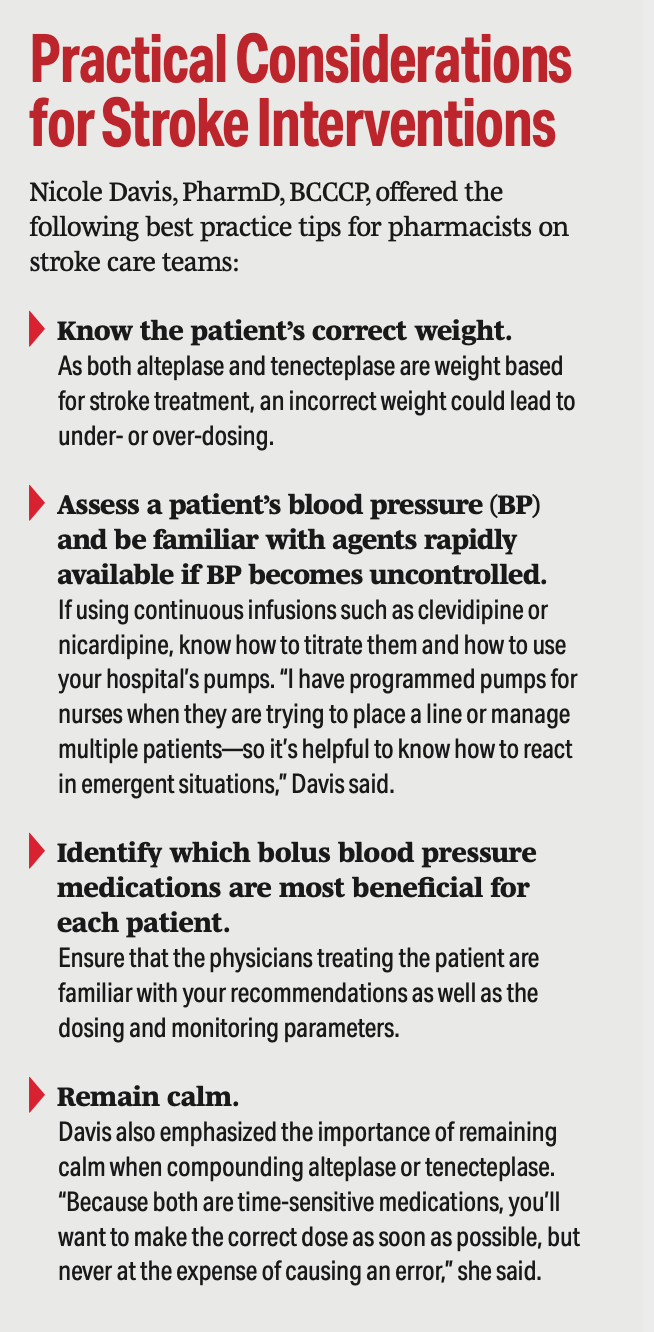Integrating Pharmacists Into Stroke Care Teams
Pharmacist inclusion in stroke interventions improves patient outcomes.

Medications used to treat stroke are complex and their preparations are complicated. Pharmacists’ knowledge and familiarity with these brain-saving medications is crucial in the typically narrow time windows to effectively treat stroke patients, according to Deborah Sadowski, RPh, BSPharm, MHA, director of pharmacy services at Deborah Heart and Lung Center in Browns Mills, New Jersey.
“The pharmacist is uniquely positioned to assess the safety and appropriateness of these medications for each patient as well as dose and prepare them in a safe and expedient manner,” Sadowski said.
As a result, including pharmacists in stroke care teams can greatly improve patient outcomes. They can be incorporated into a stroke patient care team in a variety of practice settings, including inpatient units, outpatient clinics, and community pharmacies, in addition to emergency departments.
At Mount Sinai Hospital in New York, New York, clinical pharmacist Nicole Davis, PharmD, BCCCP, an assistant professor in the Department of Pharmacy Practice at Touro College of Pharmacy, also in New York, said the pharmacy team is alerted when a stroke patient arrives in the emergency department. When this occurs, a pharmacist will bring a thrombolytic directly to the bedside to assess eligibility as well as to compound the medication. The patient is then transferred to the neurology intensive care unit (ICU) or to a step-down unit or floor bed depending upon their condition, where they are followed by an ICU-trained pharmacist or inpatient pharmacist.
Kristina Stein, PharmD, a neurology clinical pharmacist at the University of Alabama at Birmingham Hospital, is part of a multidisciplinary team that responds to “code strokes.” She receives an alert when a patient has a neurologic change or event that could be concerning for a stroke. “Pharmacists can identify candidates for thrombolytic therapy and reduce time to thrombolytic therapy,” she said. Furthermore, they can facilitate adjunctive therapy, such as blood pressure control or reversing anticoagulation therapy in the case of hemorrhagic strokes.
Pharmacists can also participate in medication reconciliation, secondary stroke prevention, risk reduction, patient counseling and education, and transitions of care initiatives. Stein attends transition-of-care rounds, where she meets with an interdisciplinary group to review each patient with stroke. She also counsels patients who start oral anticoagulants during their hospitalization or who will start one after discharge, works with providers to choose the best agent for patients, and helps monitor heparin, enoxaparin, and warfarin.
Stein would advise smaller organizations to train some inpatient pharmacists in stroke care. First gauge staff interest, then have that group develop a continuing education presentation or other training session. Choose someone who is interested in this effort to take ownership and be responsible for developing house-wide education. The 2019 update to the Guidelines for the Early Management of Patients With Acute Ischemic Stroke is a great place to start when developing education.
If an institution is looking for other ways to incorporate pharmacists into stroke care, opportunities exist with developing or reviewing stroke electronic order sets; completing competencies in stroke identification, management, and thrombolytic therapy administration; participating in stroke simulation education experiences; and serving on stroke committees, Stein added.
Getting a Pharmacist On Board
When looking to make a change, such as adding a pharmacist to a stroke care team, it’s helpful to have a physician promote it. After a pharmacist has joined the team, Alyssa Bernard, PharmD, a patient care pharmacist in the stroke unit and neurosensory ICU at Jefferson Hospital for Neuroscience in Philadelphia, Pennsylvania, recommends a few first steps. To begin with, she said, it’s important to review team- and unit-specific policies and procedures, as well as team- and unit-specific disease states and guidelines.
Bernard’s stroke unit and intermediate neurosensory step-down units are the hospital’s only non-ICU units in which IV push administration of labetalol and hydralazine is permitted. “Having some baseline knowledge about disease states that a pharmacist will focus on and the workings of a new unit will allow a pharmacist to make more targeted and useful recommendations to their team,” she said.
Bernard also advises establishing the best point of contact for recommendations and other messages, as well as obtaining other team members’ communication preferences. Her usual go-to individual is a junior resident, but the entire team should be informed of interventions that involve radically changing a patient’s therapy.

Facilitating Appropriate Medication Use
Pharmacists can facilitate appropriate medication use by familiarizing themselves with the latest acute ischemic stroke guidelines from the American Heart Association and American Stroke Association, including secondary prevention strategies (ie, antiplatelets, statin therapy, blood pressure management, glucose control, and vasospasm prevention after subarachnoid hemorrhage). This will enable them to intervene throughout a patient’s hospital stay and encourage optimal pharmacotherapy, according to Doug Humber, PharmD, a health sciences clinical professor and clinical pharmacist specialist at Skaggs School of Pharmacy and Pharmaceutical Sciences Department of Pharmacy at the University of California, San Diego.
Humber also noted that pharmacists can be involved in developing computerized prescriber order sets for alteplase to ensure that appropriate decision pathways are followed and that medication orders are entered and viewed in a timely manner. Moreover, hospitals can incorporate pharmacists into the development of an acute stroke care pathway. This would include all aspects of the alteplase process, such as indications and contraindications for alteplase, dosing and administering alteplase, and monitoring patients after giving alteplase, explained Humber.
Further, Bernard noted there are many ways in which a pharmacist can assist in proper medication usage in an inpatient setting, but one that is often overlooked is route of administration. Many patients with stroke experience difficulty swallowing as one of their major presenting symptoms. These patients require nutritional support and medication administration via tubes. “It is vital, therefore, that a pharmacist know which medications can be crushed and which interact with tube feedings,” she said. This can also extend to which medications can be given rectally or converted to IV formulations if a patient does not yet have other access to their gastrointestinal system.
Pharmacists also need to be aware of the different outcome measures for preventing future strokes. Ensuring that patients have good outpatient poststroke discharge plans is important to make sure they are monitored for high blood pressure, high cholesterol, diabetes management, smoking cessation, and other health maintenance concerns, according to Sarah Clark, PharmD, BCPS, a senior pharmacy manager for neurology, psychiatry, and emergency medicine, at Mayo Clinic in Rochester, Minnesota. Outpatient pharmacists can play a role in the ongoing medication management of these patients.
By working collaboratively with providers, pharmacists can build mutual trust and confidence with them, making providers more open to accepting recommendations from pharmacists on medication use. This partnership will benefit patients and provide them with optimum care through team collaboration, Sadowski said.
Karen Appold is a medical writer in Lehigh Valley, Pennsylvania.
Newsletter
Pharmacy practice is always changing. Stay ahead of the curve with the Drug Topics newsletter and get the latest drug information, industry trends, and patient care tips.
